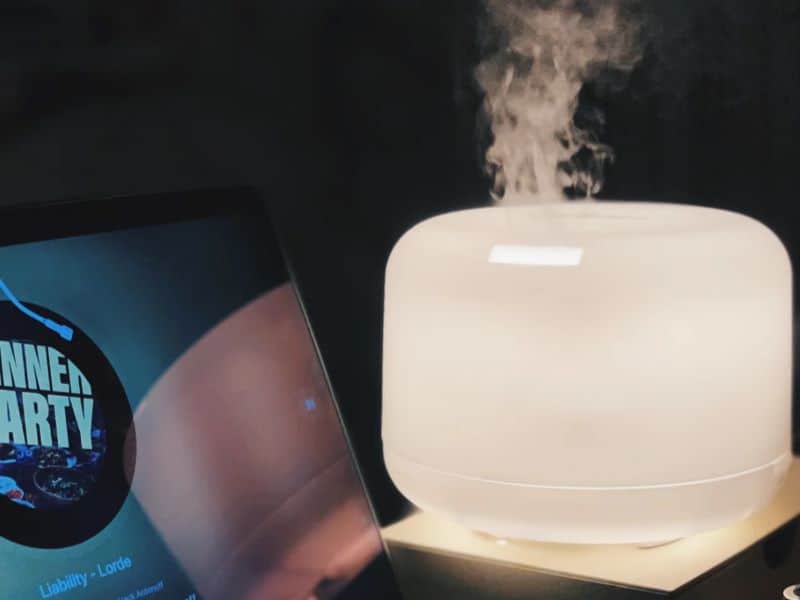If you enjoy pleasant essential oil fragrances rising from your diffuser, you may wonder what else you might be able to drop inside of it.
But putting the wrong things inside your diffuser can cause it to get clogged or malfunction in damaging ways. You will void your manufacturer’s warranty if you pour anything but water and essential oils into your diffuser.
If you’re low on essential oils, you may opt to simply not use your diffuser. And here’s a list of reasons why.

9 Facts About What to Put In a Diffuser
The function of a diffuser is to disperse a fragrant mist throughout your home while benefiting from the healing properties of the essential oils being diffused. Nice smells can make your space feel more homey but not just anything that smells nice can be poured into a diffuser.
Here’s what you need to know about what you can and cannot put inside your diffuser:
Can You Put Perfume In a Diffuser?
Ethanol is the primary ingredient used to make perfume. It’s an alcohol base that can comprise up to 90% of the perfume formula.
To this base, perfumers add natural ingredients. Some examples include the essence of flowers, roots, bark, spices, fruit, leaves, resins, gums, and grasses. Even animal excrement, like ambergris, is used in some of the world’s most expensive perfumes.
There’s often some amount of solvents and fixatives added to the natural oils and chemical fragrance mixtures. Water is usually part of the formula as well. It aids in scent longevity and dilutes the alcohol, making the perfume gentler on the skin.
Perfumes are complex substances that can irritate the skin and trigger allergic reactions. There are a number of potential health risks that can result from the exposure to some of the ingredients used in perfumes.
There’s often some amount of solvents and fixatives added to the natural oils and chemical fragrance mixtures. Water is usually part of the formula as well. It aids in scent longevity and dilutes the alcohol, making the perfume gentler on the skin.
Perfumes are complex substances that can irritate the skin and trigger allergic reactions. There are a number of potential health risks that can result from the exposure to some of the ingredients used in perfumes.
Perfumes are not directly regulated. Companies are allowed to withhold the full list of their ingredients in order to protect their proprietary formulas. While certain ingredients are monitored, the Food and Drug Administration (FDA) has a relaxed standard. The products only need to be generally recognized as safe.
With its combination of raw materials, solvents, chemicals, and other substances that fragrance companies are not forced to publicly declare, it would probably be best not to put perfume in a diffuser. Its consistency would probably mist well, but you wouldn’t quite know what you’re inhaling. People with sensitivities should never put perfume in their diffuser.
Can You Put Cologne In a Diffuser?
Colognes are usually marketed to men as perfumes are typically marketed towards women. Although less concentrated, like perfume, cologne is considered a cosmetic product because it’s used to help make a person more attractive.
Similarly, cologne ingredients do not need to be FDA approved before being marketed and sold to customers.
As long as ingredients aren’t poisonous, filthy, or otherwise, “injurious to health,” then it is generally permitted.
Cologne is mostly made up of alcohol and fragrant oils. But there could be fixatives, solvents and other ingredients in the mix as well.
The thing to keep in mind is that it’s mostly made of chemical ingredients. According to Health Care Without Harm, these “fragrance chemicals can cause headaches; eye, nose, and throat irritation; nausea; forgetfulness; loss of coordination, and other respiratory and/or neurotoxic symptoms.”
Individuals with asthma and sinus conditions are especially vulnerable to fragrance formulas.
You can imagine that diffusing cologne can lead to a lot of discomfort for some people. And because not all of the ingredients are listed, you may not even know that you’re allergic to them until you’re exposed to the fragrance. Even if you want to diffuse cologne that you enjoy wearing, you may not want to inhale the other chemical ingredients as a fine mist of particles.
Cologne is a thin enough consistency to be added to water in an ultrasonic diffuser but just because it can technically diffuse, that doesn’t mean you could safely diffuse it.
Can You Put Fragrance Oils In a Diffuser?
The role of a diffuser is to break essential oils down into tiny particles to breathe in their beneficial properties. Fragrance oils are either partially or wholly chemically-based aromatic compounds. Essential oils might be added to fragrance oils, but if they are, it’s usually a very small percentage.
This means that you would be inhaling chemicals, not the health benefits derived from diffusing essential oils. Carrier oils are sometimes added to fragrance oil formulas as well. These thicker oils prevent diffusers from misting properly.
Fragrance oils are not suitable for aromatherapy. There are no health benefits to diffusing fragrance oils, and you might be inhaling toxic chemicals if you add fragrance oils to your diffuser.
Can You Put Vanilla Extract In a Diffuser?
If you bake or stir up your own vanilla lattes at home, you’re probably familiar with vanilla extract ingredients. Vanilla is one of the most popular flavors worldwide but only 1% of vanilla is actually derived naturally from the vanilla orchid.
Madagascar, Mexico, and Indonesia are the three most common places where vanilla orchids are cultivated.
It’s increasingly rare, and therefore, increasingly expensive.
To keep up with demand, companies “combine synthetic, semi-synthetic and natural versions of the vanillin molecule” (Chemical and Engineering News). This is partially due to the fact that there aren’t enough vanilla beans grown in the world to meet consumer demand.
Pure vanilla extract is the liquid solution that results from soaking vanilla beans in alcohol. The alcohol literally extracts the vanilla flavor from the beans.
But according to the FDA, there are five optional ingredients that your vanilla extract might also contain:
- Glycerin
- Propylene glycol
- Sugar
- Dextrose
- Corn syrup
High quality vanilla extract should only include three ingredients: vanilla bean, alcohol (no more than 35%), and water.
If you’re interested in diffusing vanilla extract, then I’d urge you to question the potential effects that inhaling concentrated levels of alcohol might have on your body. The alcohol could be absorbed into your bloodstream. Plus, if you happen to have imitation vanilla flavoring or a vanilla extract with additives, you may not know what you’re inhaling.
Vanilla smells lovely, can relieve symptoms of depression, and other health conditions. But I’d suggest you stick to vanilla essential oils in order to experience those benefits.
Can You Put Lemon Juice In a Diffuser?
Pouring lemon juice into your diffuser would be unhelpful and might even clog it up.
Since the citrus fragrances that we love are extracted from the rind, pouring in lemon juice won’t produce the concentrated lemony fragrance you might be looking to experience.
Aside from low fragrance output, if the juice isn’t sifted well, tiny seeds and portions of the pulp might find their way into the inner workings of your diffuser – creating a problem.
If you want your home to smell like fresh lemons, it would be much more effective to do one of three things.
- Diffuse lemon essential oil
- Simmer lemon rinds on the stove for a fresh pot of potpourri
- Clean your home with a solution made with lemon essential oil
If you opt for the potpourri, be sure to keep an eye on it. Water can evaporate more quickly than we realize.
Can You Put Epsom Salt In a Diffuser?
Salt is abrasive and can damage the ultrasonic plate in your diffuser. Also epsom salt is typically used for soaking sore, achy muscles, not inhaling. It can also be a great stress reliever when bathing, although there’s insufficient scientific evidence to support either claim.
Inhaling salty air, or, halotherapy, has been trending as an alternative medical treatment for a number of health conditions, particularly ones involving the respiratory system.
Although this treatment is controversial and not yet proven to be effective, Himalayan salt, not epsom salt, is most frequently used in dry air halotherapy. Soaking in an epsom salt bath is considered a DIY alternative to wet halotherapy.
But overall, you wouldn’t accomplish anything but damage to your diffuser if you put epsom salts inside of it. If you’re struggling with a medical condition, talk to your doctor or a licensed alternative medical professional for effective treatment ideas.
If you want to use epsom salts for aromatherapy, that’s possible. Pour epsom salt into a glass or ceramic bowl or jar, and then sprinkle about a dozen drops of essential oils on top of the salts. They will fragrance the room for at least a few days. When the scent fades, you can drop more oil on top of the salts.
Can You Put Vinegar In a Diffuser?
The best way to clean your diffuser is to add water and a couple teaspoons of vinegar, and then run the machine as described in this post.
If you run your diffuser regularly, you’ll want to clean it this way at least once a week. Use your discretion for infrequent use. But always clean your diffuser with vinegar before storing it for a long period of time.
Can You Put Wallflower Oil In a Diffuser?
I would discourage you from doing this as well. A very small amount of essential oils are typically added to wallflower oil formulas. Specific fragrance ingredients are not added to the label, but you can read all of the solvents, stabilizers, and colorants that’ve been added to the oil.
Inhaling these ingredients over the course of a month or two at low heat levels is tolerable. But inhaling these ingredients in the concentrated levels produced by a diffuser would be less than desirable.
For your health, avoid diffusing wallflower oils.
Can You Put Warming Oil In a Diffuser?
Although warming oils like this one are made using essential oils, those aren’t the only ingredients. Warming oils are blended with carrier oils like jojoba, almond, argan, coconut, or grapeseed oils. All of these oils would be too thick for a diffuser to convert into a mist.
Some warming oils are not only thick but also sticky, and there’s no way they would properly diffuse.
Natural ingredients aside, putting warming oils in a diffuser would likely cause the diffuser to stop working. And unfortunately the manufacturer wouldn’t repair or replace it if it’s still under warranty because of user error.
Final Thoughts
Diffusers were invented to help promote a healthy lifestyle. Particles diffused into the air enter into your respiratory tract then into your bloodstream, so you want to be mindful about what you are inhaling.
For your health and in order to get the best use out of your diffuser, it’s recommended that you only put water and essential oils inside of your diffuser. If you’re using a nebulizing diffuser, only pour essential oils inside of it, not water. Vinegar treatments clean ultrasonic diffusers and alcohol treatments clean nebulizing diffusers.
As well as using a diffuser you can also try infrared recovery, which is also a great relaxing alternative.
And the absolute best practice is to follow the instruction manual included with your diffuser. If you like this article, please share on all the socials!
Read more:
